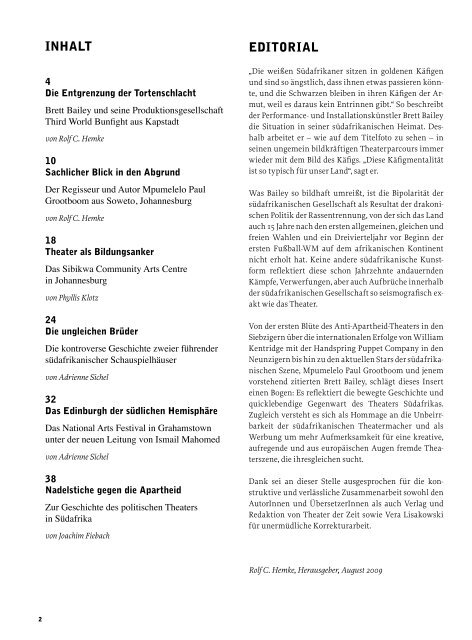AUFBRUCH IM LAND DER KÄFIGE Neues Theater in Südafrika ...
AUFBRUCH IM LAND DER KÄFIGE Neues Theater in Südafrika ...
AUFBRUCH IM LAND DER KÄFIGE Neues Theater in Südafrika ...
Erfolgreiche ePaper selbst erstellen
Machen Sie aus Ihren PDF Publikationen ein blätterbares Flipbook mit unserer einzigartigen Google optimierten e-Paper Software.
INHALT<br />
EDITORIAL<br />
„Die weißen <strong>Südafrika</strong>ner sitzen <strong>in</strong> goldenen Käfigen<br />
4<br />
und s<strong>in</strong>d so ängstlich, dass ihnen etwas passieren könn-<br />
Die Entgrenzung der Tortenschlacht<br />
te, und die Schwarzen bleiben <strong>in</strong> ihren Käfigen der Armut,<br />
weil es daraus ke<strong>in</strong> Entr<strong>in</strong>nen gibt.“ So beschreibt<br />
Brett Bailey und se<strong>in</strong>e Produktionsgesellschaft<br />
der Performance- und Installationskünstler Brett Bailey<br />
<br />
die Situation <strong>in</strong> se<strong>in</strong>er südafrikanischen Heimat. Des-<br />
von Rolf C. Hemke<br />
halb arbeitet er – wie auf dem Titelfoto zu sehen – <strong>in</strong><br />
se<strong>in</strong>en ungeme<strong>in</strong> bildkräftigen <strong>Theater</strong>parcours immer<br />
10<br />
wieder mit dem Bild des Käfigs. „Diese Käfigmentalität<br />
Sachlicher Blick <strong>in</strong> den Abgrund<br />
ist so typisch für unser Land“, sagt er.<br />
<br />
Was Bailey so bildhaft umreißt, ist die Bipolarität der<br />
<br />
südafrikanischen Gesellschaft als Resultat der drakoni-<br />
von Rolf C. Hemke<br />
schen Politik der Rassentrennung, von der sich das Land<br />
auch 15 Jahre nach den ersten allgeme<strong>in</strong>en, gleichen und<br />
18<br />
freien Wahlen und e<strong>in</strong> Dreivierteljahr vor Beg<strong>in</strong>n der<br />
<strong>Theater</strong> als Bildungsanker<br />
ersten Fußball-WM auf dem afrikanischen Kont<strong>in</strong>ent<br />
nicht erholt hat. Ke<strong>in</strong>e andere südafrikanische Kunst-<br />
<br />
form reflektiert diese schon Jahrzehnte andauernden<br />
<br />
Kämpfe, Verwerfungen, aber auch Aufbrüche <strong>in</strong>nerhalb<br />
der südafrikanischen Gesellschaft so seismografisch ex-<br />
von Phyllis Klotz<br />
akt wie das <strong>Theater</strong>.<br />
24<br />
Von der ersten Blüte des Anti-Apartheid-<strong>Theater</strong>s <strong>in</strong> den<br />
Die ungleichen Brüder<br />
Siebzigern über die <strong>in</strong>ternationalen Erfolge von William<br />
<br />
Kentridge mit der Handspr<strong>in</strong>g Puppet Company <strong>in</strong> den<br />
<br />
Neunzigern bis h<strong>in</strong> zu den aktuellen Stars der südafrikanischen<br />
Szene, Mpumelelo Paul Grootboom und jenem<br />
von Adrienne Sichel<br />
vorstehend zitierten Brett Bailey, schlägt dieses Insert<br />
e<strong>in</strong>en Bogen: Es reflektiert die bewegte Geschichte und<br />
32<br />
quicklebendige Gegenwart des <strong>Theater</strong>s <strong>Südafrika</strong>s.<br />
Das Ed<strong>in</strong>burgh der südlichen Hemisphäre Zugleich versteht es sich als Hommage an die Unbeirr-<br />
<br />
barkeit der südafrikanischen <strong>Theater</strong>macher und als<br />
<br />
Werbung um mehr Aufmerksamkeit für e<strong>in</strong>e kreative,<br />
aufregende und aus europäischen Augen fremde Thea-<br />
von Adrienne Sichel<br />
terszene, die ihresgleichen sucht.<br />
38<br />
Dank sei an dieser Stelle ausgesprochen für die kon-<br />
Nadelstiche gegen die Apartheid<br />
struktive und verlässliche Zusammenarbeit sowohl den<br />
<br />
AutorInnen und ÜbersetzerInnen als auch Verlag und<br />
Redaktion von <strong>Theater</strong> der Zeit sowie Vera Lisakowski<br />
<br />
für unermüdliche Korrekturarbeit.<br />
von Joachim Fiebach<br />
Rolf C. Hemke, Herausgeber, August 2009<br />
2 3<br />
INDEX<br />
39<br />
P<strong>in</strong>holes aga<strong>in</strong>st Apartheid<br />
A Brief History of Political Theatre<br />
<br />
by Joachim Fiebach<br />
EDITORIAL<br />
“White South Africans sit <strong>in</strong> their golden cages terrified<br />
5<br />
that someth<strong>in</strong>g might happen to them and the blacks<br />
No Holds Barred for the Cake Battle<br />
stay <strong>in</strong> their cages of poverty because there’s no escape.”<br />
That’s how performance and <strong>in</strong>stallation director Brett<br />
<br />
Bailey, a native of South Africa, describes the country’s<br />
<br />
situation. Thus – as can be seen on the cover – the image<br />
by Rolf C. Hemke<br />
of a cage is a recurrent theme <strong>in</strong> his visually powerful<br />
theatre productions. “This cage mentality is so typical<br />
11<br />
for our country”, he says.<br />
Star<strong>in</strong>g Dispassionately <strong>in</strong>to the Abyss<br />
Bailey depicts the bipolarity of South African society as<br />
<br />
a result of the draconian politics of racial segregation<br />
<br />
which still affect the country today, 15 years after the<br />
by Rolf C. Hemke<br />
first free and equal elections, and n<strong>in</strong>e months before<br />
the first ever FIFA World Cup will be held on the African<br />
cont<strong>in</strong>ent. No other South African art form reflects<br />
19<br />
the decades-long conflict and distortion as well as the<br />
Theatre as an Anchor for Education<br />
progress made with such seismographic precision like<br />
<br />
theatre does.<br />
<br />
This issue covers the first bloom of anti-apartheid thea-<br />
by Phyllis Klotz<br />
tre <strong>in</strong> the seventies and the <strong>in</strong>ternational success of William<br />
Kentridge and the Handspr<strong>in</strong>g Puppet Company <strong>in</strong><br />
25<br />
the n<strong>in</strong>eties, as well as the recent stars of the South Af-<br />
The Unequal Brothers<br />
rican scene: Mpumelelo Paul Grootboom and the above-<br />
<br />
quoted Brett Bailey. It reflects on the turbulent history of<br />
South African theatre and sees itself as a tribute to the<br />
unswerv<strong>in</strong>g South African theatre community. It aims<br />
by Adrienne Sichel<br />
to draw attention to an outstand<strong>in</strong>g theatre scene, so utterly<br />
creative, excit<strong>in</strong>g and exotic to European eyes.<br />
33<br />
Ed<strong>in</strong>burgh of the Southern Hemisphere<br />
Special thanks to the constructive and reliable contribu-<br />
<br />
tions of the writers and translators as well as the pub-<br />
<br />
lisher and editorial team of <strong>Theater</strong> der Zeit, and Vera<br />
Lisakowski for her tireless edit<strong>in</strong>g work.<br />
by Adrienne Sichel<br />
Rolf C. Hemke, editor, August 2009



